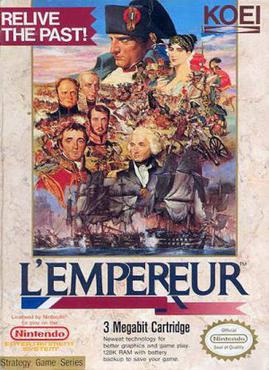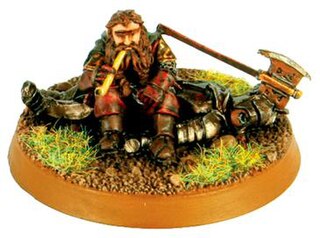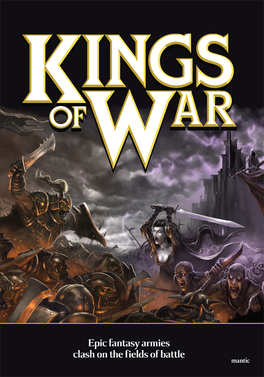
Mordheim is a tabletop game published by Games Workshop in 1999. It is a variant of the company's Warhammer Fantasy game set on a warband or "skirmish" scale. Mordheim was designed by Alessio Cavatore, Tuomas Pirinen, and Rick Priestley. Alongside the basic skirmish game, Mordheim also features a campaign system, where Warbands gain experience and equipment as the campaign progresses, in a similar nature to role-playing games.

Warmaster is a ruleset for tabletop wargames written by Rick Priestley, published by Specialist Games, and set in the Warhammer Fantasy setting. It is different from Warhammer Fantasy Battles in both appearance and gameplay. It is intended for 10 –12 mm miniatures. Basic troops are based on stands, of which typically three make a unit. Generals, Heroes and Wizards are mounted individually or with their retinue.

L'Empereur is a turn-based strategy video game for the Nintendo Entertainment System released by the Koei company in 1989.

Napoleon in Europe is a board wargame produced by Eagle Games in 2001. It combines elements of economics, politics, and military strategy. The map for the game was illustrated by the artist Paul Niemeyer.

Middle Earth Strategy Battle Game, previously marketed as The Lord of the Rings Strategy Battle Game, The Hobbit: An Unexpected Journey Strategy Battle Game, The Hobbit: The Desolation of Smaug Strategy Battle Game and The Hobbit: The Battle of Five Armies Strategy Battle Game, is a tabletop miniature wargame produced by Games Workshop. It is based on The Lord of the Rings and The Hobbit film trilogies directed by Peter Jackson, and the books that inspired them, written by J. R. R. Tolkien.

Wallenstein is a medium-weight German-style board game designed by Dirk Henn and published by Queen Games in 2002. Though set during the Thirty Years' War, Wallenstein should not be confused with a complex wargame. Rather, it has the feel of a light strategy game with the familiar Euro elements of area control and resource management mixed in. As such, it has a wide range of appeal that attracts wargamers and non-wargamers alike.
Matrix Games is a publisher of PC games, specifically strategy games and wargames. It is based in Ohio, US, and Surrey, UK.

The War of the Ring was Games Workshop's annual summer campaign for 2005. The campaign was named after the eponymous War of the Ring in J. R. R. Tolkien's The Lord of the Rings, and was the first to feature The Lord of the Rings Strategy Battle Game as its wargaming system. The campaign allowed registered participants to play miniature wargames using special "regional rules" for any one of thirteen regions of Middle-earth, and to submit the results to the campaign website. The results were then added up on the website, contributing to the overall result of the campaign.
Real-time tactics (RTT) is a subgenre of tactical wargames played in real-time, simulating the considerations and circumstances of operational warfare and military tactics. It is differentiated from real-time strategy gameplay by the absence of classic resource micromanagement and base or unit building, and by the greater importance of individual units and a focus on complex battlefield tactics.

Richard "Rick" Priestley is an English miniature wargame designer and writer. He co-created the miniature wargame Warhammer Fantasy Battle and its science fiction counterpart Warhammer 40,000 during his tenure at Games Workshop in the 1980s and 1990s. Following his time at Games Workshop, he went on to establish Warlord Games and co-create other titles such as Bolt Action.

Revolt On Antares is a science fiction themed microgame designed by Tom Moldvay and produced by TSR, Inc. in 1981. Similar to the microgames produced by Steve Jackson Games, it was sold in a transparent plastic shell case and came with rulebook, full-color hex-map, counters, and one six-sided die. Other games in this series include They've Invaded Pleasantville!, Remember the Alamo, Attack Force, Vampyre, Viking Gods, Icebergs and Saga.

Brigandine is a turn-based strategy game for the PlayStation video game console, created by developer Hearty Robin and released in 1998. It was released in North America by Atlus the same year, under the title Brigandine: The Legend of Forsena. In 2000, Hearty Robin released an expanded version of the game called Brigandine: Grand Edition, which included multiplayer support along with other new features. In the game, the player chooses one of the nations of the fictional continent of Forsena, and has the goal of conquering the other nations by taking their castles, using troops composed of humanoid commanders and fictional creatures. Although primarily a strategy game, it also includes some characteristics of tactical role-playing games.

Slitherine Software UK Limited is a British video game developer and publisher founded on 25 June 2000. It is responsible for the production of a range of over 200 strategy and war video games. Slitherine developed and/or published a number of licensed games with brands including Battlestar Galactica, Warhammer 40,000, Starship Troopers, Horrible Histories and The History Channel. It also produces rules for a series of tabletop wargames called Field of Glory.

The Kings' Crusade is a real-time strategy video game with elements of role-playing. It was developed by NeocoreGames, and was published in October 2010 by Paradox Interactive. In Russia the game was published by 1C Company and Snowball Studios called Kings' Crusade. Lionheart.

Kings of War, is a tabletop wargame created by Mantic Games.
Alessio Cavatore is a game designer.
Age of Napoleon is a 2003 war and strategy board game created in collaboration between Mayfair Games and Phalanx Games. It focuses on the Napoleonic Wars in Europe from 1805 to 1815. The game's designer is Renaud Verlaque and its artist is Franz Vohwinkel.

Bolt Action is a miniature wargame produced by Warlord Games. It is set during World War II and uses 28mm-sized models. The game was developed by Alessio Cavatore and Rick Priestley. The first edition of the rulebook was published in 2012, and the second edition was published in 2016. Supplements for the game include The Korean War and Konflikt '47, set in a Dieselpunk and supernatural alternate history of World War II.

The Emperor Returns is a Napoleonic board wargame published in 1986 by Clash of Arms that asks "What if Napoleon had won the Battle of Waterloo?".


















